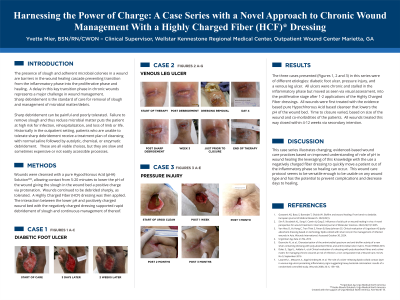Case Series/Study
(CS-097) Harnessing the Power of Charge: A Case Series with a Novel Approach to Chronic Wound Management
Friday, May 2, 2025
7:45 PM - 8:45 PM East Coast USA Time

Introduction: The presence of slough and biofilm in a wound are barriers in the wound healing cascade preventing movement out the inflammatory phase into the proliferative phase and onto healing. This key transition phase in chronic wounds represents a major challenge in outpatient wound management.
Sharp debridement is the standard of care for removal of slough and management of biofilm. Sharp debridement can be painful and poorly tolerated. Failure to remove slough and manage biofilm puts the patient at high risk for infection, rehospitalization, and loss of limb or life. Historically in the outpatient setting, patients who are unable to tolerate sharp debridement receive a treatment plan of cleansing with normal saline followed by autolytic, chemical, or enzymatic debridement. These are all viable choices, but they are slow processes.
Methods: Wounds were cleansed with a pure hypochlorous acid solution, allowing contact from 5-20 minutes to lower the pH of wound giving wound bed a positive charge. Wounds continued to be debrided sharply, as tolerated. A negatively charged fiber dressing was then applied. The interaction between the lower pH and positively charged wound bed with the negatively charged dressing supported rapid debridement of slough and continuous management of biofilm.
Results: The three cases presented in this series were of different etiologies: diabetic foot ulcer, pressure injury, and a venous leg ulcer. All ulcers were chronic and stalled in the inflammatory phase but moved into the proliferative stage after 1-2 applications of a dressing with negatively charged hydrofibers, after being cleaned with a wound cleanser that lowers the pH of a wound bed. Time to closure varied based on size of the wound and co-morbidities of the patients. All closed within 4-12 weeks.
Discussion: This case series illustrates changing, evidenced-based wound care practices based on improved understanding of role of pH in wound healing and how this can be leveraged with the use a negatively charged fiber dressing to quickly move a patient out of the inflammatory phase so healing can occur. This wound care protocol can be used on any wound type and has the potential prevent complications and decrease days to healing.
Sharp debridement is the standard of care for removal of slough and management of biofilm. Sharp debridement can be painful and poorly tolerated. Failure to remove slough and manage biofilm puts the patient at high risk for infection, rehospitalization, and loss of limb or life. Historically in the outpatient setting, patients who are unable to tolerate sharp debridement receive a treatment plan of cleansing with normal saline followed by autolytic, chemical, or enzymatic debridement. These are all viable choices, but they are slow processes.
Methods: Wounds were cleansed with a pure hypochlorous acid solution, allowing contact from 5-20 minutes to lower the pH of wound giving wound bed a positive charge. Wounds continued to be debrided sharply, as tolerated. A negatively charged fiber dressing was then applied. The interaction between the lower pH and positively charged wound bed with the negatively charged dressing supported rapid debridement of slough and continuous management of biofilm.
Results: The three cases presented in this series were of different etiologies: diabetic foot ulcer, pressure injury, and a venous leg ulcer. All ulcers were chronic and stalled in the inflammatory phase but moved into the proliferative stage after 1-2 applications of a dressing with negatively charged hydrofibers, after being cleaned with a wound cleanser that lowers the pH of a wound bed. Time to closure varied based on size of the wound and co-morbidities of the patients. All closed within 4-12 weeks.
Discussion: This case series illustrates changing, evidenced-based wound care practices based on improved understanding of role of pH in wound healing and how this can be leveraged with the use a negatively charged fiber dressing to quickly move a patient out of the inflammatory phase so healing can occur. This wound care protocol can be used on any wound type and has the potential prevent complications and decrease days to healing.

.jpg)